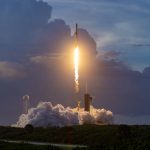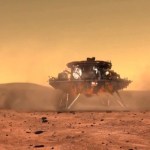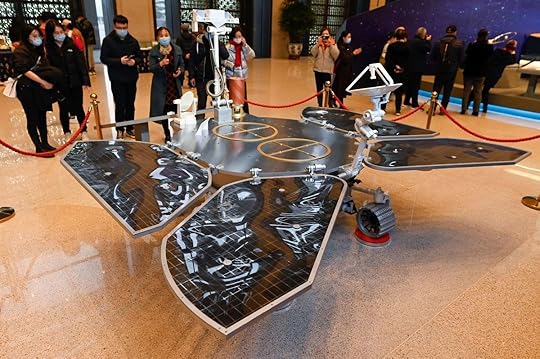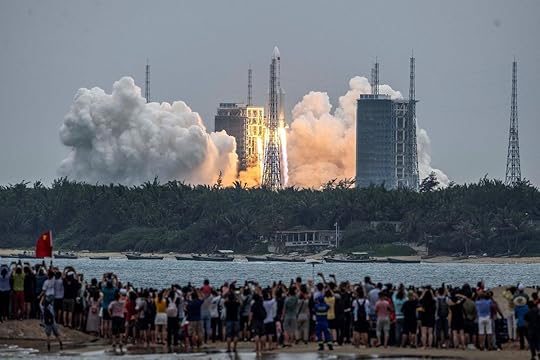Dominique Luchart's Blog, page 623
May 15, 2021
Introducing Nuwa, the sustainable Mars megacity of the future: Exclusive interview, ,

Ready to pack your bags and hit the cosmic highway for a new off-world home? The folks at ABIBOO Studio and SONet are putting out the welcome mat and presenting their vision for what might become the first capital city on Mars, housing up to 250,000 residents.
The city, called Nuwa, was brilliantly conceived by ABIBOO and SONet, a scientific think tank headed by astrophysicist Guillem Anglada, who led the discovery of exoplanet Proxima b. It’s a visionary concept for a completely scalable, sustainable Red Planet metropolis carved into the 3,000-foot (1,000 meters) cliff face of Tempe Mensa, and was selected as a finalist by The Mars Society’s 2020 contest for feasible settlement designs.
ABIBOO founder and chief architect Alfredo Munoz and his team created the comprehensive design work and its stunning digital artwork, including urban parks and hydroponic gardens, that have Earthlings yearning for a one-way ticket to this large-scale Martian community.
The ABIBOO team thinks construction could begin as early as 2054 and welcome the first wave of colonists by 2100.
According to their official report, the design includes five cities, with Nuwa as the capital and each city hosting 200,000 to 250,000 people. The rest of the settlements mirror the urban strategy. For example, Abalos City would be located at Mars’ north pole to leverage ice access, and Marineris City would be in Valles Marineris, one of the biggest canyons in the solar system.
Space.com spoke with internationally known architect Alfredo Munoz about his involvement in the Nuwa city project, his enthusiasm for its modular blueprints, why he believes it’s a global construction enterprise for the ages, what the team’s imaginative influences were in its conception and more.
[image error]
An artist’s rendering of Nuwa. (Image credit: ABIBOO Studio/SONet)Space.com: What’s your role in this ambitious project, and what excites you most about its potential?
Alfredo Munoz: I’m the founder of ABIBOO Studio, which is an international architectural firm. But I’m also on the board of directors of SONet, a multidisciplinary group with experts in different fields in the space industry. We were interested in using the group to provide solutions for sustainable innovations in an outer space settlement. Together, we designed the Nuwa city project, which we believed could be the first sustainable city on Mars.
Space.com: How did you approach the aesthetic and logistical concerns for Nuwa city?
Munoz: I think it was a combination of factors. First, it was the vision and the challenge that The Mars Society contest proposed. Coming up with a permanent settlement for 1 million people was the core of the stratification for the city. Up until now, there have been other solutions for settlements on Mars, but nothing like this. The challenge for a small amount of people to live temporarily on Mars is a completely different strategy from a design point of view than coming up with a city that must improve the lives of people who are born and live and die in the city.
From a design aspect, Nuwa was created by top scientists in a variety of fields. That gives the project a strong confidence that the design is valid and feasible. It’s not just about beautiful images and beautiful architectural solutions. It’s got experts behind it, and it was innovative in the way we solved so many of the challenges we’ll face while setting up a Mars settlement. We did it in a very scalable manner, creating spaces that will be potentially exciting and beautiful. Architecture is not always about solving problems; it’s about creating art.
[image error]
An artist’s rendering of Nuwa. (Image credit: ABIBOO Studio/SONet)That combination is what myself and the team on this project were able to bring. The marriage between strong technical and scientific solutions, along with innovative architectural ideas, as well as The Mars Society’s vision, has created the amount of new interest in society saying that this is really possible. Why not be optimistic with a permanent city on Mars?
With urban planning projects, we often face issues where we need to create identity. How can we create environments that are attractive for people so it creates a sense of identity and belonging? It goes beyond beauty. It’s about the emotional well-being of the people that are going to enjoy and live in that space. That was critical for us and something we wanted to do from the very beginning.
Space.com: What does the chosen name “Nuwa” mean?
Munoz: Nuwa comes from Chinese mythology. There was a goddess that created the universe and protected humans from all the bad things that happen, and her name was Nuwa. So when we were talking to SONet about potential names, we thought it was a fantastic representation — not only of what the name means, but also how we envision Nuwa as a multicultural location.
Most of the team is from Europe and the United States, but we thought to bring in Asian culture and Asian background that compensated for that lack of Asian aspects on the team. Again, we envision Nuwa city as a completely inclusive city with people coming from all backgrounds, and we thought this was a beautiful opportunity on both fronts. We really want this to be global.
[image error]
An artist’s rendering of Nuwa. (Image credit: ABIBOO Studio/SONet)Space.com: What were some of your influences in creating this Mars megacity?
Munoz: It’s funny; we really didn’t look at science fiction when we were trying to solve the problems we have on Mars. Consciously, there’s always some influence from things like “Blade Runner,” and that movie had a very big impact on architects in my generation.
In my case, it was more of my experience with Toyo Ito. He’s one of the most influential architects alive. He was granted the prestigious Pritzker [Architecture] Prize in 2013, which is the equivalent of the Nobel Prize, and he’s the architect I worked with years ago in Japan. He gives a lot of importance to systems that can be replicated in a very conceptually easy manner.
So when I approached this with the rest of the team, it was very important to come up with something that was simple, scalable and able to generate an identity. We never really went back to science fiction. We were trying to do engineering and architecture. Sometimes, when you look at references that are visually too appealing, you can let go of that anchor of science.
[image error]
An artist’s rendering of Nuwa. (Image credit: ABIBOO Studio/SONet)Space.com: Besides the challenges of creating enough breathable air and tunneling technologies, what are other obstacles that need to evolve for Nuwa to be born?
Munoz: Yes, there are some critical parts that we’ve identified that exist ahead, and until those parts are resolved, we won’t be able to properly implement construction on a scale like Nuwa. The first one is the fact that we’ll be relying on steel. Based on the scientists, it will be relatively easy to obtain steel from water and CO2, which can create carbon. We’re basically building the entire city with local resources. We’re barely bringing things from Earth, which is critical for that scalability and sustainability. We’ll still need to test and develop that technology before going ahead.
Another challenge is that we will need on-the-ground confirmation from a geological point of view that the location conditions are appropriate, and that requires actual astronauts — the same way that here on Earth, we’re not going to perforate the mountain without doing the proper site analysis. A lot can be done with robotics, but some astronauts will need to be there.
The use of artificial intelligence and robotics will also be critical. The way the robotics industry is going, in more than 20 years, we’ll be more than ready to have the know-how to start construction. But even if the city is ready to be built, we still need to bring the population to actually live there.
[image error]
An artist’s rendering of Nuwa. (Image credit: ABIBOO Studio/SONet)One of the biggest hurdles we found is that, due to the two-year window of opportunity, [planetary alignment for most efficient transit time to Mars] the amount of rockets required to send 250,000 people from Earth to Mars will be huge. Even if [SpaceX CEO] Elon Musk is doing great work and will be able to send humans to Mars very soon, the volume needed is completely mind-blowing. Our engineers are working on ideas of how we can scale that component up. We are hopeful that in the next 30 years, we’ll get to the point where those critical parts are resolved so we can start implementing a construction like Nuwa on Mars.
Space.com: It’s difficult to put a price tag on such a monumental endeavor, but what would you speculate as the costs for Nuwa?
Munoz: We were basically comparing it to what the Panama Canal cost back in time. We’re talking about a large infrastructure that takes decades to build and requires a lot of commitment. The impact it can have concerning well-being and commerce can be staggering.
We still have no detailed analysis of cost. It’s a primary process, and we’re working on trying to build prototypes and getting the right partners and financing to continue moving forward. We have a journey of many years ahead, and part of that journey will be doing a detailed breakdown of costs. If we solve some of these obstacles in the next 10 years, we’ll have a much better idea.
[image error]
An artist’s rendering of Nuwa. (Image credit: ABIBOO Studio/SONet)If we compare it with 60 years ago, when Yuri Gagarin went into space, the amount of complexities involved for trying to send someone into orbit were staggering. In 60 years, which will be 2081, if we compare back in time how much humans have been able to develop technology, we could be in a position where we could speed up our timeline beyond what we’re currently targeting. Sixty years is nothing.
Space.com: How do you hope your conceptual Martian city will stir the imaginations of future generations?
Munoz: I’m really passionate about education, and I’ve been involved in academia and teaching in the past. I think the role that education can have is huge. And architecture has a critical role in having either a positive or negative impact for future generations. To be able to create a plan and be part of the team that came up with a highly scalable solution that could be a road map for a permanent settlement on Mars, to come up with such a landmark in what being a human is and what society can become, is so enriching as a professional. It’s fascinating.
Follow us on Twitter @Spacedotcom and on Facebook.
The post Introducing Nuwa, the sustainable Mars megacity of the future: Exclusive interview, , appeared first on NEWDAWN Blog.
SpaceX will launch 52 Starlink satellites and two small payloads tonight. Watch it live!, ,

CAPE CANAVERAL, Fla. — SpaceX will launch its third Falcon 9 rocket in two weeks Saturday evening (May 15), with the launcher carrying a new fleet of Starlink broadband satellites into space, and you can watch the action live online.
The private spaceflight company will launch 52 Starlink satellites on one of its workhorse rockets, a Falcon 9 dubbed B1058, along with a nanosatellite for Tyvak and a small radar satellite for Capella Space.
The frequent flier is scheduled to blast off from Pad 39A here at NASA’s Kennedy Space Center in Florida at 6:54 p.m. EDT (2054 GMT).
You can watch the launch live here and on the Space.com homepage, courtesy of SpaceX, beginning about 15 minutes before liftoff. You can also watch the launch directly via SpaceX.
Related: SpaceX’s Starlink satellite megaconstellation launches in photos
[image error]
SpaceX’s Falcon 9 rocket booster B1058 launches 60 Starlink internet satellites into space from Pad 39A of NASA’s Kennedy Space Center in Cape Canaveral, Florida on Oct. 6, 2020. It was the third flight for the Falcon 9 booster. (Image credit: SpaceX)Saturday’s flight is the 15th Falcon 9 mission for SpaceX so far in 2021 — all of which have flown on previously used boosters. The mission, called Starlink 27, is the third such mission to launch this month and follows SpaceX’s latest record-setting flight that blasted off on Sunday (May 9). That flight starred one of SpaceX’s fleet leaders and oldest boosters, B1051, which made its 10th launch and landing — the first in SpaceX’s fleet to do so.
The company debuted a souped-up version of its workhorse Falcon 9 rocket in 2018, with the intent to foster reusability. By adding some new features that would allow the booster to better withstand the stresses of launch, the company said that each Falcon 9 would be able to fly at least 10 times with minimal refurbishment in between launches, and 100 times total.
As the company aims to fill its burgeoning megaconstellation with thousands of broadband satellites, it will continue to push Falcon 9 to the limit, reserving the boosters with the most flights under their belts for its Starlink program. (SpaceX will fly its paying customers on new boosters or those that have minimal flights.)
SpaceX created its Starlink program in hopes of providing high-speed internet access to users around the world, and as a means to help fund its deep space ambitions. The service is targeted to users in rural or remote areas that have little-to-no connectivity, although anyone can use it.
To date, the company has launched more than 1,600 of the flat-paneled satellites into space. SpaceX estimated it would need at least 1,440 satellites in its initial constellation to begin to roll out commercial service. While that hasn’t happened just yet, the company is working towards a commercial rollout later this year.
Before it can offer up commercial service, SpaceX has been busy putting its Starlink program through its paces as part of a now global beta-testing program called “Better than nothing beta.” The company reports that more than 500,000 people have signed up for the service so far.
Prospective users can pay a small deposit sign up for the service now, via the company’s website. However, it could be a few months before the actual service becomes available.
Related: SpaceX launches 60 Starlink satellites and lands rocket in dazzling nighttime liftoff
[image error]
SpaceX deploys 60 Starlink internet satellites into orbit after launching on a record 10th flight from Space Launch Complex 40 at Cape Canaveral Space Force Station in Florida, on May 9, 2021. (Image credit: SpaceX)[image error]
A SpaceX Falcon 9 rocket B1058, carrying the South Korean military communications satellite Anasis-II, stands atop Space Launch Complex 40 of the Cape Canaveral Air Force Station, Florida for a July 20, 2020 launch. (Image credit: SpaceX)Saturday’s launch marks the 119th flight overall for SpaceX’s 229-foot-tall (70 meters) Falcon 9 booster. The star of the mission is one of SpaceX’s flight leaders: a seven-time veteran Falcon 9 first stage, designated B1058.
This frequent flyer, adorned with NASA’s iconic worm logo, made its debut in 2020 with the launch of two NASA astronauts — Bob Behnken and Doug Hurley. Strapped inside a Crew Dragon capsule, the duo blasted off a two-month mission to the International Space Station, as part of the Demo-2 test flight.
As part of NASA’s commercial crew program, their historic flight marked the return of human spaceflight from Florida’s Kennedy Space Center since the end of the shuttle program in 2011. (Previously, NASA relied on Russia to transport its astronauts.)
The booster also launched a communications satellite for South Korea’s military, the largest payload of small satellites ever delivered to orbit, an upgraded cargo Dragon capsule, and is now set to launch its fourth Starlink mission.
If all goes as planned, B1058 will blast off early on Saturday evening and approximately 9 minutes later, will touch down on one of SpaceX’s two drone ships, named “Of Course I Still Love You.” If successful, it will mark the 86th recovery of a first stage booster since the company landed its first one in December 2015.
The weather outlook looks good for Saturday’s liftoff, with forecasters at the 45th Weather Squadron predicting a 70% chance of favorable launch conditions. The concerns are liftoff winds and the potential for cumulus clouds. Officials also say that sea states at the recovery zone look good.
There is a backup launch opportunity, if necessary, on Sunday (May 16), with weather conditions improving slightly.
SpaceX has already deployed its newest recovery vessel, a brightly painted pink and blue ship named Shelia Bordelon. The vessel is charged with retrieving the payload fairings after they fall back to Earth. The fairings make up a protective clamshell-like piece of hardware that protects the payload as the rocket climbs to orbit.
Once the rocket reaches a certain altitude, the fairing pieces are jettisoned and then fall back to Earth. With the help of onboard navigation software and special parachutes, the two pieces will gently land in the Atlantic ocean, where they will be scooped up by the Shelia Bordelon.
Follow Amy Thompson on Twitter @astrogingersnap. Follow us on Twitter @Spacedotcom or Facebook.
The post SpaceX will launch 52 Starlink satellites and two small payloads tonight. Watch it live!, , appeared first on NEWDAWN Blog.
May 14, 2021
China’s 1st Mars rover ‘Zhurong’ lands on the Red Planet, ,

China just successfully landed its first rover on Mars, becoming only the second nation to do so.
The Tianwen-1 mission, China’s first interplanetary endeavor, reached the surface of the Red Planet Friday (May 14) at approximately 7:11 p.m. EDT (2311 GMT), though Chinese space officials have not yet confirmed the exact time and location of touchdown. Tianwen-1 (which translates to “Heavenly Questions”) arrived in Mars’ orbit in February after launching to the Red Planet on a Long March 5 rocket in July 2020.
After circling the Red Planet for more than three months, the Tianwen-1 lander, with the rover attached, separated from the orbiter to begin its plunge toward the planet’s surface. Once the lander and rover entered Mars’ atmosphere, the spacecraft endured a similar procedure to the “seven minutes of terror” that NASA’s Mars rovers have experienced when attempting soft landings on Mars.
Related: China’s Tianwen-1 Mars mission in photos
A heat shield protected the spacecraft during the fiery descent, after which the mission safely parachuted down to the Utopia Planitia region, a plain inside of an enormous impact basin in the planet’s northern hemisphere. Much like during NASA’s Perseverance rover landing, Tianwen-1’s landing platform fired some small, downward-facing rocket engines to slow down during the last few seconds of its descent.
The China National Space Administration (CNSA) has not yet officially confirmed the successful landing, but it has been announced on social media by the state-run China Global Television Network (CGTN) and by researchers at Macau University of Science and Technology in China.
See more
China’s Mars rover, called after an ancient fire god in Chinese mythology, will part ways with the lander by driving down a foldable ramp. Once it has deployed, the rover is expected to spend at least 90 Mars days (or about 93 Earth days; a day on Mars lasts about 40 minutes longer than a day on Earth) roving around on Mars to study the planet’s composition and look for signs of water ice. Utopia Planitia is believed to contain vast amounts of water ice beneath the surface. It’s also where NASA’s Viking 2 mission touched down in 1976.
[image error]
An image of Utopia Planitia taken by the Tianwen-1 orbiter at an altitude of about 220 miles (350 kilometers). (Image credit: CNSA)The six-wheeled rover, which is about the size of NASA’s twin Mars rovers Spirit and Opportunity, carries six scientific instruments on board, including two panoramic cameras, a ground-penetrating radar and a magnetic field detector. It also has a laser that it can use to zap rocks and study their composition, as well as a meteorological instrument to study the climate and weather on Mars.
Zhurong will work in tandem with the Tianwen-1 orbiter to study the Red Planet, and the orbiter will serve as a data relay station for communications between Zhurong and mission controllers on Earth. The orbiter is designed to last for at least one Mars year, or about 687 Earth days.
Image 1 of 5[image error]
An artist’s concept of China’s first Mars rover mission, Tianwen-1, at the Red Planet. (Image credit: CCTV/China National Space Administration)Image 2 of 5[image error]
An artist’s concept of Tianwen-1’s descent to the Utopia Planitia. (Image credit: CCTV/China National Space Administration)Image 3 of 5[image error]
An artist’s concept of China’s first Mars rover mission, Tianwen-1, landing on the Red Planet using retropropulsion thrusters. (Image credit: CCTV/China National Space Administration)Image 4 of 5[image error]
An artist’s illustration of China’s first Mars rover Zhurong preparing to depart the lander by rolling down a ramp. (Image credit: CNSA)Image 5 of 5[image error]
An artist’s concept of China’s Tianwen-1 rover being deployed from the lander on the Red Planet. (Image credit: CCTV/China National Space Administration)Tianwen-1 may be China’s first Mars landing mission, but it isn’t China’s first Mars shot. The first, an orbiter called Yinghuo-1, launched in 2011 with Russia’s failed Phobos-Grunt Mars sample-return mission, which never made it past Earth’s orbit after launch, instead crashing into the Pacific Ocean and destroying the spacecraft.
China is now the second nation to successfully land a Mars rover (NASA has landed five rovers on Mars). The successful orbit insertion of the Tianwen-1 mission in February made China the sixth entity to do so, following NASA, the Soviet Union, the European Space Agency (ESA), India and the United Arab Emirates.
Aside from China and NASA, the Soviet Union is the only other country to have landed a probe on Mars, but that mission (called Mars 3) ended prematurely when the spacecraft failed only a few minutes after it landed. The European Space Agency has attempted two Mars landings, but both spacecraft crashed.
Tianwen-1 is China’s first interplanetary mission; until now, Chinese spacecraft haven’t ventured beyond Earth’s moon, where the nation has successfully landed two rovers as part of its Chang’e program, which most recently brought moon rocks to Earth in December. China is also planning to launch an ambitious Mars sample-return mission in 2028, much like a joint NASA and ESA sample-return mission scheduled to launch that same year.
In the meantime, China is working on building its new space station, the first piece of which launched in April — and caused global panic last week when large rocket debris came tumbling to Earth in an uncontrolled fashion. China is also collaborating with Russia on an asteroid sample-return mission scheduled to launch in 2024.
Email Hanneke Weitering at hweitering@space.com or follow her on Twitter @hannekescience. Follow us on Twitter @Spacedotcom and on Facebook.
The post China’s 1st Mars rover ‘Zhurong’ lands on the Red Planet, , appeared first on NEWDAWN Blog.
China has landed on Mars,

China landed its first pair of robots on the surface of Mars on Friday, state-affiliated media confirmed on social media, becoming the second country to do so successfully after overcoming a daring, seven-minute landing sequence. The country’s Tianwen-1 spacecraft ejected the rover-lander bundle for a Martian touchdown at around 7PM ET, kicking off a mission to study the Red Planet’s climate and geology.
The mission marks China’s first independent trek to Mars, about 200 million miles away from Earth. Only NASA has successfully managed to land and operate rovers on the planet in the past. (The Soviet Union’s Mars 3 spacecraft landed on the planet in 1971 and communicated for about 20 seconds before unexpectedly going dark.) China’s mission, involving three spacecraft working together, is ambitiously complex for a first-timer — the first US mission, Viking 1 in 1976, only involved a lander deployed from its probe.
The landing took place at Utopia Planitia, a flat swath of Martian land and the same region where NASA’s Viking 2 lander touched down in 1976. After touching down, the lander will unfurl a ramp and deploy China’s Zhurong rover, a six-wheeled solar-powered robot named after the god of fire in ancient Chinese mythology. The rover carries a suite of onboard instruments, including two cameras, a Mars-Rover Subsurface Exploration Radar, Mars Magnetic Field Detector, and Mars Meteorology Monitor.
The Tianwen-1 spacecraft launched from the Wenchang Spacecraft Launch Site in China’s Hainan province on July 23rd last year, setting off on a seven-month trek to the Red Planet. The spacecraft trio “has functioned normally” since it entered Mars orbit in February, the China National Space Administration (CNSA) said in a statement Friday morning. It collected a “huge amount” of scientific data and snapped photos of Mars while in its orbit.
 Photo by Wang Zhao / AFP via Getty Images
Photo by Wang Zhao / AFP via Getty ImagesThe Tianwen-1 orbiter, clutching the rover-lander bundle, has been scoping out the Utopia Planitia landing site for over three months, flying close to Mars every 49 hours in an elliptical orbit (an egg-shaped orbital pattern), according to Andrew Jones, a journalist covering China’s activities in space.
Now on the Martian surface, the Zhurong rover will embark on a mission of at least three months to study Mars’ climate and geology.
“The main task of Tianwen-1 is to perform a global and extensive survey of the entire planet using the orbiter, and to send the rover to surface locations of scientific interests to conduct detailed investigations with high accuracy and resolution,” the mission’s top scientists wrote in Nature Astronomy last year. The roughly 240kg rover is nearly twice the mass of China’s Yutu Moon rovers.
Tianwen-1 is the name of the overall Mars mission, named after the long poem “Tianwen,” which means “Questions to Heaven.” It marks the latest in a quick succession of advances in space exploration for China. The country became the first nation in history to land and operate a rover on the far side of the Moon in 2019. It also completed a brief lunar sample mission in December last year, launching a robot to the Moon and swiftly returning it back to Earth with a cache of Moon rocks for evaluation.
 China’s Long March 5B, the same rocket used to send Tianwen-1 to Mars, launches a space station module last month.Photo by STR / AFP via Getty Images
China’s Long March 5B, the same rocket used to send Tianwen-1 to Mars, launches a space station module last month.Photo by STR / AFP via Getty ImagesMore recently, China launched the first core module of its planned space station, Tianhe, which will serve as living quarters for groups of astronauts. The rocket that launched that module spawned an international freakout over where on Earth it might reenter. (It eventually reentered over the Indian Ocean, and large chunks of the rocket splashed down roughly 30 miles off an island in the Maldives, the Chinese government said.)
Despite this ambitious trek to Mars with its trio of three robots, China’s focus seems to be fixed on the Moon — the same immediate destination for NASA’s Artemis program. Earlier this year, China announced plans to build a lunar space station and base on the Moon’s surface with Russia, NASA’s longtime partner on the International Space Station.
Update, 8:12PM ET: Added that we’re now waiting for official word from China as to whether the mission was a success or failure.
Update, 8:47PM ET: Now with confirmation.
The post China has landed on Mars, appeared first on NEWDAWN Blog.
Twitter politely asks you to protect its targeted ad dollars in new iOS 14.5 prompt, Ian Carlos Campbell

 Illustration by Alex Castro / The Verge
Illustration by Alex Castro / The VergeAs part of iOS 14.5, Apple’s App Tracking Transparency forces developers to ask permission for something they used to be able to do for free: track iOS users. Today, Twitter is joining the ranks of other developers and adding a prompt that asks users to enable tracking on iOS (via MacRumors).
Twitter’s main justification for listening to its request is straightforward — having the feature enabled allows it to serve “better” ads. The company includes a link to settings so you can make those changes, but read Twitter’s explanation before you decide:
Keep ads relevant to you by allowing Twitter to track data from other companies on this device, like apps you use and websites you visit.
The company also includes a link to a support post in…
The post Twitter politely asks you to protect its targeted ad dollars in new iOS 14.5 prompt, Ian Carlos Campbell appeared first on NEWDAWN Blog.
Twitter politely asks you to protect its targeted ad dollars in new iOS 14.5 prompt,

As part of iOS 14.5, Apple’s App Tracking Transparency forces developers to ask permission for something they used to be able to do for free: track iOS users. Today, Twitter is joining the ranks of other developers and adding a prompt that asks users to enable tracking on iOS (via MacRumors).
Twitter’s main justification for listening to its request is straightforward — having the feature enabled allows it to serve “better” ads. The company includes a link to settings so you can make those changes, but read Twitter’s explanation before you decide:
Keep ads relevant to you by allowing Twitter to track data from other companies on this device, like apps you use and websites you visit.
The company also includes a link to a support post in the Twitter help center which explains why it has to ask for permission, includes a link to its current App Privacy Policy, and goes over what enabling or disabling tracking does in iOS.
 The new Twitter ad tracking prompt.
The new Twitter ad tracking prompt.It’s a surprisingly low-key attempt to get users to allow Twitter to track them, considering the company highlighted Apple’s addition of App Tracking Transparency in iOS 14.5 as a potential risk in its recent earnings statement (PDF):
We continue to expect total revenue to grow faster than expenses in 2021, assuming the global pandemic continues to improve and that we see modest impact from the rollout of changes associated with iOS 14.5. How much faster will depend on various factors, including our execution on our direct response roadmap and macroeconomic factors.
Facebook and Instagram took a far more aggressive approach to convince users its use of ad tracking is on the up-and-up — even going as far as including a vague threat that enabling tracking will “help keep Facebook/Instagram free of charge.”
Companies like Twitter and Facebook rely on tracking users to support their separate, often very lucrative ad businesses. After all, it’s usually ad sales that pay for free social networks, and customer data helps to target those ads. As a company that’s more interested in selling hardware and subscription services, Apple doesn’t really have to worry about things like that, but brash changes like the new tracking permissions can leave developers scrambling.
App Tracking Transparency has proven popular, though — around 96 percent of US users are opting out of tracking according to some recent surveys. And with Google considering developing its own methods for blocking tracking on Android, we might just have to get used to apps coming to us and begging for free data.
The post Twitter politely asks you to protect its targeted ad dollars in new iOS 14.5 prompt, appeared first on NEWDAWN Blog.
Space Force renames Florida space wing as Space Launch Delta 45, ,

The “world’s premier gateway to space” now has a new name.
The 45th Space Wing at Patrick Space Force Base and Cape Canaveral Space Force Station in Florida was redesignated as Space Launch Delta 45 on Tuesday (May 11). The changeover continues the reorganization of Air Force installations to the Space Force since the latter was founded in 2019.
“I am proud of the guardians and airmen of today’s 45th Space Wing and the tens of thousands of your predecessors, who for decades have worked tirelessly to earn the wing’s preferred motto as the ‘world’s premier gateway to space,'” Lt. Gen. Stephen Whiting, commander of Space Operations Command, said in a video announcing the change. “Well, today we’re marking yet another milestone in the storied history of this space and this mission set, and I think we’ll be posturing the 45th to keep using that moniker for many decades to come.”
Related: Space Force has Biden’s ‘full support,’ White House says
Following military custom, the flags of the 45th Space Operations Group and 45th Mission Support Group were furled and encased as part of Tuesday’s ceremony.
“I stand here on Launchpad 3, where the historic Bumper 8 mission launched on July 24, 1950,” said Col. Mark Shoemaker, commander of the 45th Space Operations Group, who with superintendent CMSgt. Omar Basnight, stowed the group’s flag at the site of the first rocket launch from Cape Canaveral. “While it may not look grandiose, this site marks the beginning of the 3,737 launch and landing operations our space professionals have supported over seven decades.”
The 45th Space Wing was first activated on Nov. 12, 1991, succeeding the Eastern Space and Missile Center. The designation “45” as the wing’s unit number was based on the lineage and honors of inactivated units with the same number at Patrick Space Force Base (then Air Force Base).
[image error]
The emblem for Space Launch Delta 45 at Patrick Space Force Station and Cape Canaveral Space Force Station in Florida carries forward elements from the prior 45th Space Wing’s logo. (Image credit: USSF)[image error]
Col. Mark Shoemaker (at left), commander of the 45th Space Operations Group, and superintendent CMSgt. Omar Basnight furl and encase the group’s flag at Launchpad 3, the site of the first rocket launch from Cape Canaveral, Florida in July 1950. (Image credit: USSF)“The wing took its numerical designation from the 45th Bombardment Group, which protected our Atlantic coastlines during World War II,” said James Draper, director of the Air Force Space & Missile Museum located at Cape Canaveral Space Force Station. “During the 1991 ceremony, Lt. Gen. Thomas S. Mormon, Jr. compared the bombardment group to the space wing by pointing out both units were born of organizational change and both had to learn by doing.”
In its almost 30 year history, the 45th Space Wing supported nearly 800 launches for the country’s military and civil space programs. The wing’s first launch was STS-44, which deployed a Defense Support Program satellite into orbit by NASA’s space shuttle Atlantis. Other notable missions under the wing’s watch included the numerous shuttle flights to build the International Space Station; the introduction of United Launch Alliance’s Delta 4 and Atlas 5 rockets; interplanetary missions to Mercury, Mars, Saturn, Jupiter and Pluto; and the debut of the Air Force’s X-37B orbital test vehicle.
As part of Tuesday’s transition, the Space Force debuted the new emblem for Space Launch Delta 45.
“The midnight blue and silver gray of the delta represent the edge of Earth’s atmosphere and outer space,” Lt. Col. Shawn Bishop, chaplain for the 45th Space Wing, said, describing the arrow-shaped insignia. “In the lower center of the delta, a large globe represents the Earth, a smaller globe symbolizes the moon and other planets, and they also symbolize space travel.”
The border between the sky and space and the globes were carried over from the previous wing’s emblem to honor its history.
“The small delta’s flight path is red to indicate the stresses of launch during space flight. The path is left to right to represent prograde departure routes of launch vehicles on the Eastern Range,” said Bishop. “The number 45 proudly signifies the organization’s number and the prominent gold border represents the foundation and structure the United States Space Force provides to Space Launch Delta 45.”
The U.S. Space Force is also renaming the 30th Space Wing at Vandenberg Air Force Base in California as Space Launch Delta 30. Airmen and guardians assigned at both deltas will soon adopt another new emblem, replacing the badge for Space Operations Command with one for new Space Systems Command, under a realignment by the Space Force.
“What we do know is that no matter the patch you wear on your left shoulder, your outstanding mission accomplishment will endure,” said Lt. Gen.Whiting. “With the 45th’s rich gateway to space history as a backdrop, there will be many more firsts and many more examples of excellent mission accomplishment to advance the interests of the United States and our allies in the space domain.”
Follow collectSPACE.com on Facebook and on Twitter at @ collectSPACE . Copyright 2021 collectSPACE.com. All rights reserved.
The post appeared first on NEWDAWN Blog.
Ebay will enact a sex ban starting June 15,

If you’re hoping to turn a dollar on that extremely explicit hentai you picked up in college, you won’t be selling it on eBay. As first noticed by Adult Video News, eBay is banning the sale of most sexually explicit materials starting June 15, 2021.
Everyone has a different definition of what constitutes “sexually explicit” and eBay’s is extremely PG. While the policy is confusing in that it appears to conflate nudity and sexually explicit content, it carefully defines nudity as “showing any part of male or female genitalia, anus, or female breasts where the areola or nipple is visible.” It goes on to say that those same bits don’t get a pass if they’re covered by see-through material or confined by tight clothing. The policy also classifies “people engaged in sexual contact or activity” as nudity.
It goes on to say “most adult-only items are prohibited” and includes “sexually explicit anime, comics, books, films, animation, manga, hentai, yaoi” as among the things considered adult only.
The policy, as written, would appear to ban the sale of Game of Thrones, where “sexposition” was all the rage, as well as films like Blue is the Warmest Color. Your favorite romance novel would be safe (images, not words, appear to be the problem) but Alan Moore’s epic comic collection Lost Girls, where Wendy from Peter Pan and Dorothy from The Wizard of Oz just really go at it in more pages than I personally wanted to see, would not. Explicit comics, manga, hentai, and yaoi, which a pedantic might say are all the same thing, would be forbidden under the new policy as well.
The policy does, however, carve out an exemption for Playboy, Playgirl, Mayfair, and Penthouse. Tasteful nudes sold in the Art section would also be allowed provided poses are acceptable and there are no sexual acts. What that means for prints of any version of Leda and the Swan is up to eBay. Same would likely go for complete works of Katsushika Hokusai. The artist is best known for his woodblock print series featuring Mount Fuji, but was also known for his extremely explicit woodblock print erotica–including one of the earliest instances of “tentacle porn”.
Sex toys in unopened packages will continue to be permitted provided the packaging isn’t sexually explicit.
Censorship, even in a relatively open marketplace like eBay, is a notoriously tricky business. When Tumblr attempted to deal with its porn problem in 2018, it saw traffic take a nosedive as horny users went elsewhere. Ebay told Vice that this new ban was in the interest of safety. Banning all adult content should make it more difficult for bad actors to monetize revenge porn or other content published without the consent of all participants.
When reached for comment ebay told The Verge:
eBay is committed to maintaining a safe and trusted marketplace. Starting June 15, 2021, items showing sexual content or sexually suggestive poses will no longer be allowed on eBay.com. The “Everything Else > Adult Only” will no longer be available as a category. No new listings will be allowed in the Adult Only category and good-til-cancelled listings will be ended upon their renewal date.
The post Ebay will enact a sex ban starting June 15, appeared first on NEWDAWN Blog.
Ebay will enact a sex ban starting June 15, Alex Cranz

 Photo illustration by Jakub Porzycki/NurPhoto via Getty Images
Photo illustration by Jakub Porzycki/NurPhoto via Getty ImagesIf you’re hoping to turn a dollar on that extremely explicit hentai you picked up in college, you won’t be selling it on eBay. As first noticed by Adult Video News, eBay is banning the sale of most sexually explicit materials starting June 15, 2021.
Everyone has a different definition of what constitutes “sexually explicit” and eBay’s is extremely PG. While the policy is confusing in that it appears to conflate nudity and sexually explicit content, it carefully defines nudity as “showing any part of male or female genitalia, anus, or female breasts where the areola or nipple is visible.” It goes on to say that those same bits don’t get a pass if they’re covered by see-through material or confined by tight clothing. The policy also…
The post Ebay will enact a sex ban starting June 15, Alex Cranz appeared first on NEWDAWN Blog.
eBay will enact a sex ban starting June 15th,

If you’re hoping to turn a dollar on that extremely explicit hentai you picked up in college, you won’t be selling it on eBay. As first noticed by Adult Video News, eBay is banning the sale of most sexually explicit materials starting June 15th, 2021.
Everyone has a different definition of what constitutes “sexually explicit” and eBay’s is extremely PG. While the policy is confusing in that it appears to conflate nudity and sexually explicit content, it carefully defines nudity as “showing any part of male or female genitalia, anus, or female breasts where the areola or nipple is visible.” It goes on to say that those same bits don’t get a pass if they’re covered by see-through material or confined by tight clothing. The policy also classifies “people engaged in sexual contact or activity” as nudity.
It goes on to say “most adult-only items are prohibited” and includes “sexually explicit anime, comics, books, films, animation, manga, hentai, yaoi” as among the things considered adult only.
The policy, as written, would appear to ban the sale of Game of Thrones, where “sexposition” was all the rage, as well as films like Blue is the Warmest Color. Your favorite romance novel would be safe (images, not words, appear to be the problem) but Alan Moore’s epic comic collection Lost Girls, where Wendy from Peter Pan and Dorothy from The Wizard of Oz just really go at it in more pages than I personally wanted to see, would not. Explicit comics, explicit manga, hentai, and yaoi, which a pedantic might say are all the same thing, would be forbidden under the policy as well.
The policy does, however, carve out an exemption for Playboy, Playgirl, Mayfair, and Penthouse. Tasteful nudes sold in the Art section would also be allowed provided poses are acceptable and there are no sexual acts. What that means for prints of any version of Leda and the Swan is up to eBay. The same would likely go for the complete works of Katsushika Hokusai. The artist is best known for his woodblock print series featuring Mount Fuji, but was also known for his extremely explicit woodblock print erotica–including one of the earliest instances of “tentacle porn”.
Sex toys in unopened packages will continue to be permitted provided the packaging isn’t sexually explicit.
Censorship, even in a relatively open marketplace like eBay, is a notoriously tricky business. When Tumblr attempted to deal with its porn problem in 2018, it saw traffic take a nosedive as horny users went elsewhere. eBay told Vice that this new ban was in the interest of safety. Banning all adult content should make it more difficult for bad actors to monetize revenge porn or other content published without the consent of all participants.
When reached for comment eBay told The Verge:
eBay is committed to maintaining a safe and trusted marketplace. Starting June 15, 2021, items showing sexual content or sexually suggestive poses will no longer be allowed on eBay.com. The “Everything Else > Adult Only” will no longer be available as a category. No new listings will be allowed in the Adult Only category and good-til-cancelled listings will be ended upon their renewal date.
The post eBay will enact a sex ban starting June 15th, appeared first on NEWDAWN Blog.



